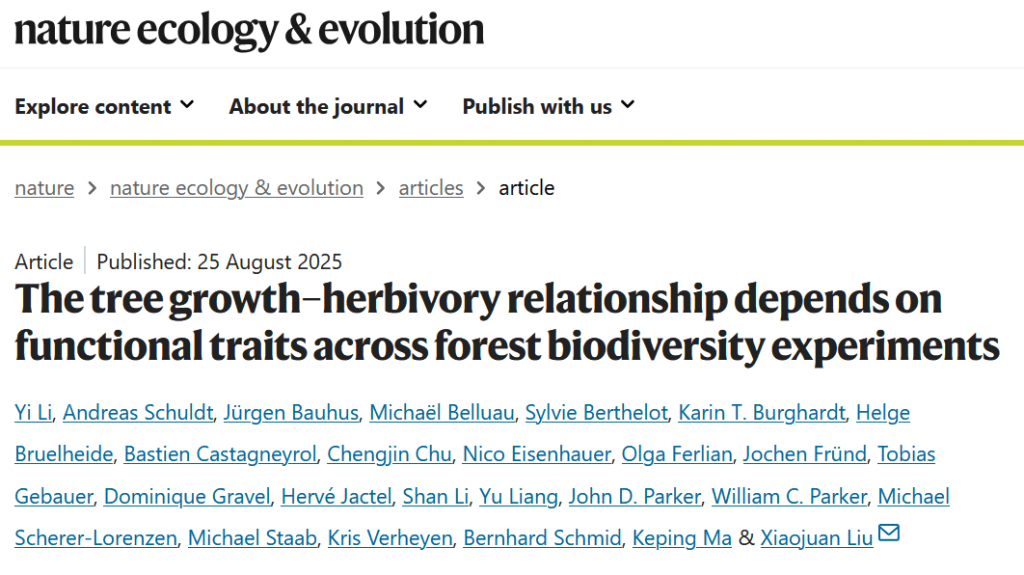
Involved members of MultiTroph: Yi Li, Andreas Schuldt, Helge Bruelheide, Shan Li, Michael Staab, Xiaojuan Liu
Summary: This study reveals that higher tree species richness and tree growth generally lead to increased insect herbivory in forests, with these effects strongest in trees with high leaf carbon-to-nitrogen ratios and tougher leaves, and further modulated by climate and soil conditions. Results show significant variation among sites, emphasizing that functional traits, especially leaf chemistry, play a central role in shaping growth–herbivory relationships across temperate and subtropical forests.
Conclusion: Forests with greater tree diversity and growth are more susceptible to insect herbivory, particularly when functional traits favor herbivore feeding, underlining the importance of trait-based approaches in ecosystem management.
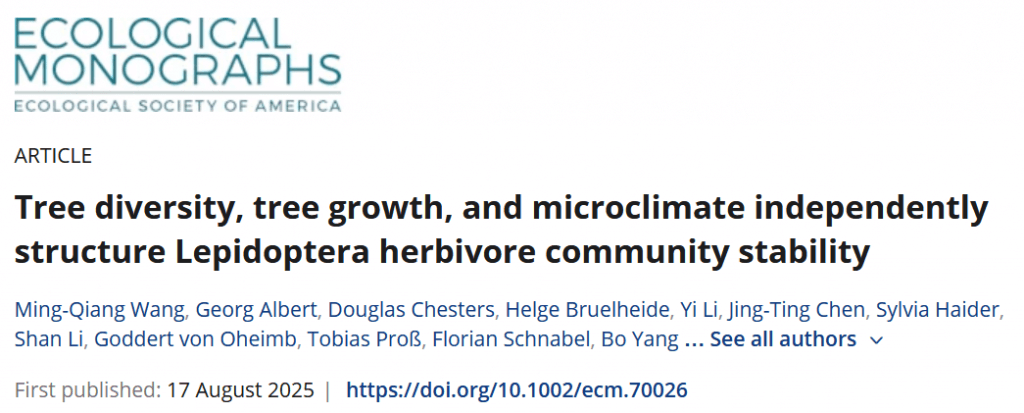
Involved members of MultiTroph: Ming-Qiang Wang, Georg Albert, Douglas Chesters, Helge Bruelheide, Yi Li, Jing-Ting Chen, Shan Li, Tobias Proß, Bo Yang, Qing-Song Zhou, Xiaojuan Liu, Chao-Dong Zhu, Arong Luo, Andreas Schuldt
Summary: This study investigates how tree species diversity, tree growth dynamics, and microclimatic conditions independently and interactively shape the stability of Lepidoptera (caterpillar) herbivore communities in subtropical Chinese forests. Using data spanning six years and three seasonal periods per year, the research assesses the effects of host tree richness, functional diversity, growth rates, and local climate on the abundance, diversity, and spatiotemporal stability of caterpillar communities.
Conclusion: The study concludes that tree diversity plays a crucial role in buffering herbivore communities against climate fluctuations, thereby promoting their spatiotemporal stability. This finding highlights the potential for biodiversity loss to increase herbivore population fluctuations and the risk of pest outbreaks.
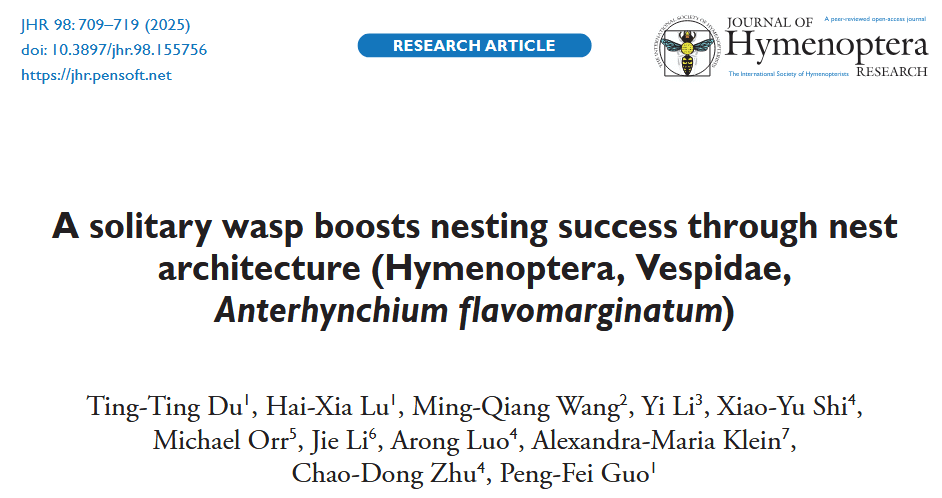
Involved members of MultiTroph: Ming-Qiang Wang, Yi Li, Michael Orr, Arong Luo, Alexandra-Maria Klein, Chao-Dong Zhu
Summary: This study investigated how nest architecture influences the nesting success of the solitary wasp Anterhynchium flavomarginatum in a subtropical forest in southwestern China. Using standardized trap nests, the researchers analyzed the effects of three structural factors: intercalary cells, nest diameter, and vestibular length. Results showed that nesting success increased significantly with the number of intercalary cells, suggesting they provide protection and spatial stability for developing larvae. Nest diameter also mattered: wasps achieved the highest success in nests 6–8 mm wide, while nests 14–16 mm performed significantly worse. Vestibular length further influenced outcomes, with nests lacking a vestibule having significantly lower success than those with vestibules ranging from 1–90 mm. Collectively, the findings highlight how nest architecture shapes reproductive success and survival in solitary wasps.
Conclusion: The study not only advances understanding of solitary wasp nesting biology but also suggests practical implications for conservation and biological pest control. By designing trap nests with optimal structural features, it may be possible to promote the population growth of these wasps and enhance their effectiveness as natural regulators of lepidopteran pests in agricultural ecosystems.
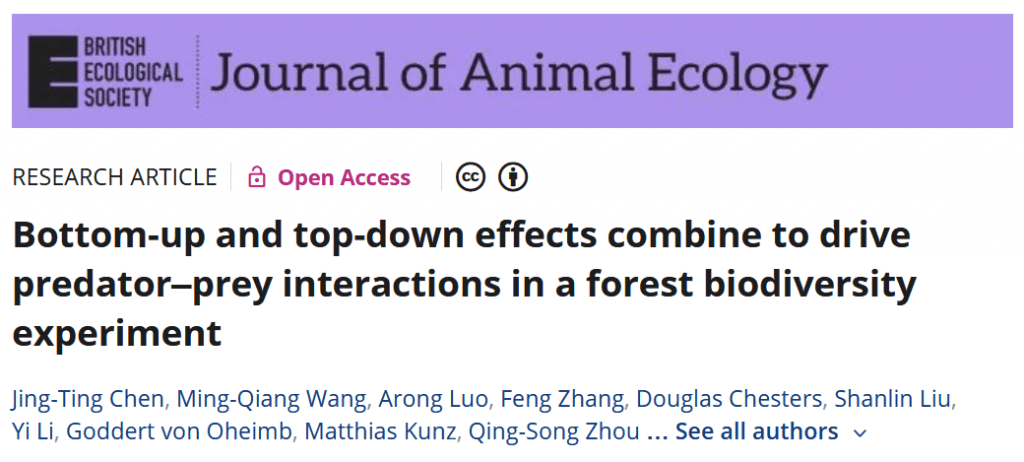
Involved members of MultiTroph: Jing-Ting Chen, Ming-Qiang Wang, Arong Luo, Douglas Chesters, Yi Li, Qing-Song Zhou, Helge Bruelheide, Xiao-Juan Liu, Andreas Schuld, Chao-Dong Zhu
Summary: This study used spider gut-content metabarcoding in a large-scale subtropical forest biodiversity experiment to investigate how tree diversity (bottom-up effects) and spider diversity (top-down effects) jointly shape prey diversity and predator–prey network structure. Results showed that tree functional diversity increased prey richness and prey sharing across all spiders, while the main drivers differed between hunting modes—phylogenetic diversity drove web-building spiders’ prey use, whereas vertical tree structure complexity shaped hunting spiders’ interactions. These patterns highlight the combined and context-dependent nature of bottom-up and top-down influences on multitrophic networks.
Conclusion: Both tree and spider community diversity strongly influence predator–prey interactions, but their relative roles depend on predator hunting mode. Integrating functional traits, phylogeny, and structural habitat diversity is essential for understanding and predicting biodiversity–ecosystem function relationships.
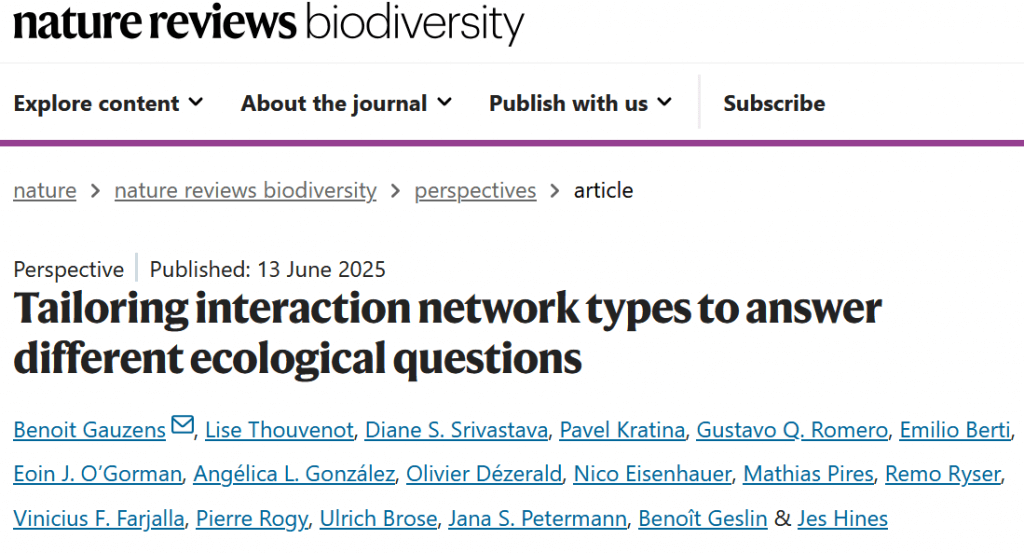
Involved member of MultiTroph: Jana Petermann
Summary: This perspective paper discusses how ecological interaction networks can be tailored to answer different ecological questions by differentiating them in two main ways: the extent of node aggregation and the type of information contained in links. It is explained that networks with nodes aggregated into functional groups are suitable for studying ecosystem-level processes, while species-level networks provide information on community assembly and how environmental factors influence species persistence. They also differentiate between networks with potential links (useful for long-term and large-scale studies) and realized interactions (providing access to finer mechanisms).
Conclusion: The authors conclude that understanding the advantages and limitations of different interaction networks will assist in methodological decision-making and increase the utility of ecological networks in biodiversity and conservation research. This guidance can help researchers choose the appropriate network type for their specific ecological questions.
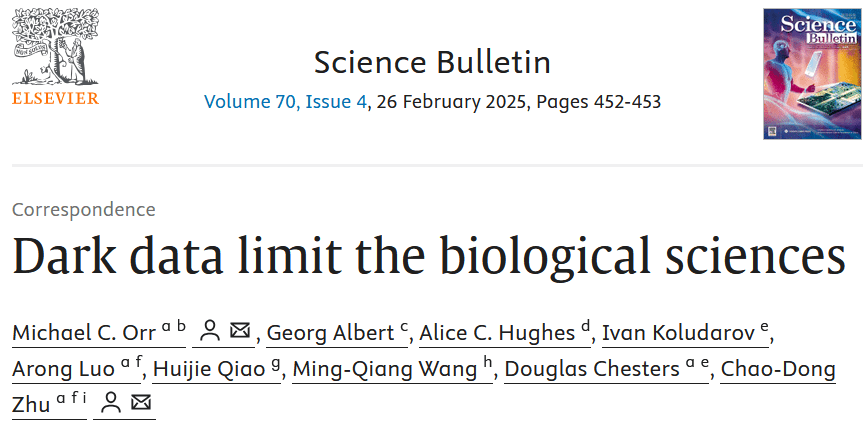
Involved members of MultiTroph: Michael C. Orr, Georg Albert, Arong Luo, Huijie Qiao, Ming-Qiang Wang, Douglas Chesters, Chao-Dong Zhu
Summary: The article discusses the challenge of ‘dark data’, i.e. scientific data that is technically available but practically inaccessible due to missing metadata, poor standardization, or disappearing repositories. The authors argue that although open science policies are spreading, inconsistent data-sharing practices hinder large-scale biological research and long-term usability. They propose standardized, future-proof data formats, mandatory metadata documentation, centralized indexing, and repository improvements (including DOIs, file-level access, and cross-linking of scripts) to ensure datasets are Complete, Legible, Error-free, Accessible, and Non-redundant (CLEAN).
Conclusion: To prevent data loss and improve reproducibility, structural changes in repositories and stronger journal policies are urgently needed, alongside retroactive efforts to recover historical dark datasets. Without immediate action, the rapid generation of new biological data will continue to be offset by equally rapid losses, perpetuating knowledge gaps.
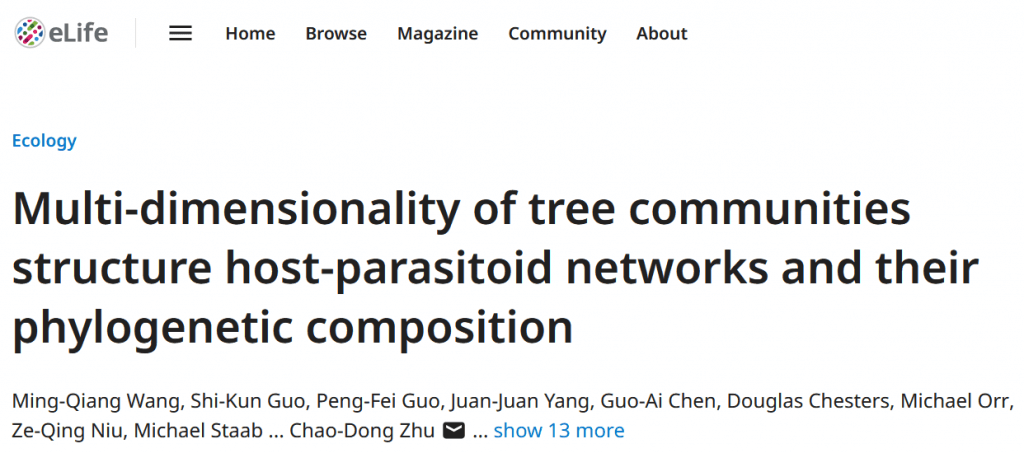
Involved members of MultiTroph: Ming-Qiang Wang, Douglas Chesters, Michael Orr, Michael Staab, Jing-Ting Chen, Qing-Song Zhu, Felix Fornoff, Xiaoyu Shi, Shan Li, Massimo Martini, Alexandra-Maria Klein, Andreas Schuld, Xiaojuan Liu, Helge Bruelheide, Arong Luo, Chao-Dong Zhu
Summary: This research explores how multiple dimensions of tree communities structure host-parasitoid networks and their phylogenetic composition. By leveraging a five-year dataset from a large-scale subtropical tree biodiversity experiment, the authors found that various components of tree diversity, such as species richness and phylogenetic diversity, as well as canopy cover, influence both the species and phylogenetic composition of host and parasitoid communities. Their findings indicate that phylogenetic associations between hosts and parasitoids reflect non-randomly structured interactions.
Conclusion: The study suggests that the composition of higher trophic levels and their corresponding interaction networks are determined by plant diversity and canopy cover, particularly through trophic links in species-rich ecosystems. These results indicate the importance of considering multiple dimensions of biodiversity when trying to understand and manage forest ecosystems.
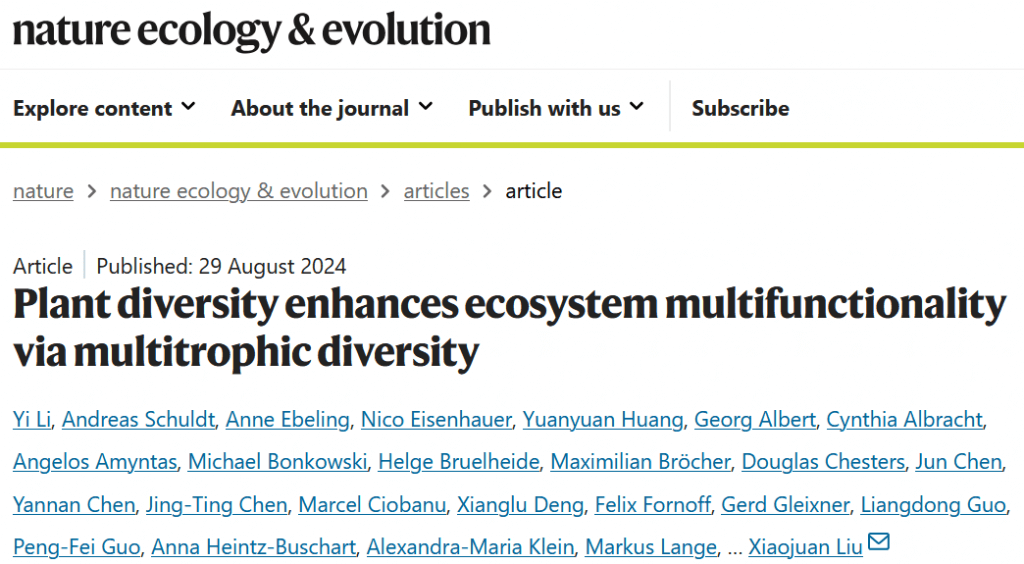
Involved members of MultiTroph: Yi Li, Andreas Schuldt, Georg Albert, Helge Bruelheide, Douglas Chesters, Jing-Ting Chen, Felix Fornoff, Peng-Fei Guo, Alexandra-Maria Klein, Shan Li, Arong Luo, Thomas Scholten, Michael Staab, Ming-Qiang Wang, Naili Zhang, Chao-Dong Zhu, Xiaojuan Liu
Summary: This study investigated the relationship between plant diversity and ecosystem multifunctionality via indirect effects on the diversity of multiple trophic levels. The research used data from two large-scale biodiversity experiments, one in a temperate grassland (Jena Experiment) and the other was our platform in BEF-China. The findings showed that plant diversity enhances multifunctionality by increasing the diversity of multiple trophic levels, such as animals and microorganisms. The study also found that the link between multitrophic diversity and multifunctionality was stronger than the relationship between the diversity of individual trophic groups and multifunctionality.
Conclusion: The findings suggest that to promote sustained ecosystem multifunctionality, conservation planning should consider the diversity of plants and higher trophic levels. The research emphasizes the importance of a multitrophic and multifunctional approach to better understand the mechanisms behind BEF relationships.
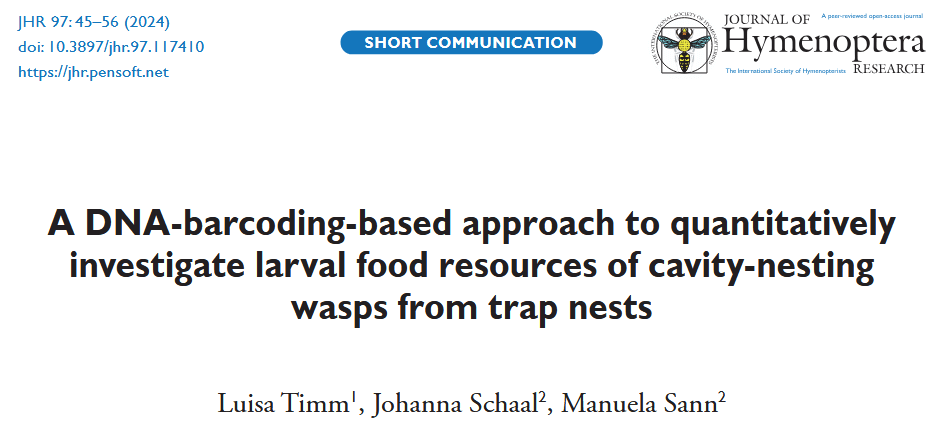
Involved member of MultiTroph: Manuela Sann
Summary: This study used a minimally invasive approach combining layer trap nests with DNA barcoding to quantitatively investigate the larval food resources and natural enemies of cavity-nesting wasps. The researchers reconstructed multi-trophic interaction networks for seven wasp species, identifying previously unknown feeding links and several prey species that are known as agricultural and forest pests. The method provides a way to quantify prey items, enabling a deeper understanding of the feeding ecology and potential for pest control.
Conclusion: The authors concluded that the combination of trap nest monitoring and DNA barcoding is an effective tool for comprehensively studying the biology of cavity-nesting Hymenoptera and their interaction partners. This approach has practical applications in species conservation and pest control by revealing valuable insights into complex ecological networks.
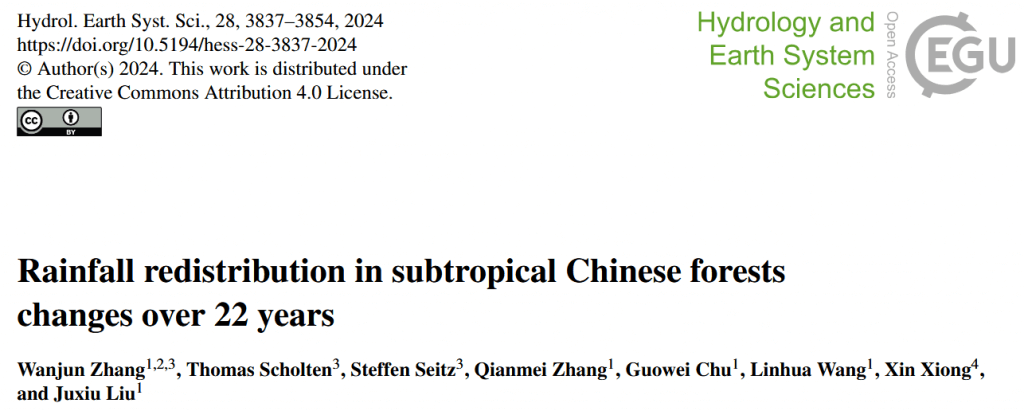
Involved members of MultiTroph: Thomas Scholten, Steffen Seitz
Summary: The study investigated how rainfall is redistributed through the canopy of subtropical forests in China and how this process has changed over 22 years (2001-2022). Based on monitoring 740 valid rainfall events, the research found that at the event scale, both the throughfall ratio (rain passing through the canopy) and the stemflow ratio (rain running down the trunk) were higher in pine forests than in mixed or broadleaf forests. Over time, throughfall and stemflow in the broadleaf forests showed higher variability compared to the other two forest types. The study also found significant differences in rainwater chemistry among the three forest types, which also changed over time.
Conclusion: The findings show that rainfall redistribution patterns change over time and that these changes are driven by both rainfall characteristics and forest type. The study provides a long-term perspective on rainfall redistribution processes by connecting changes in rainfall patterns with the stages of subtropical forest succession.
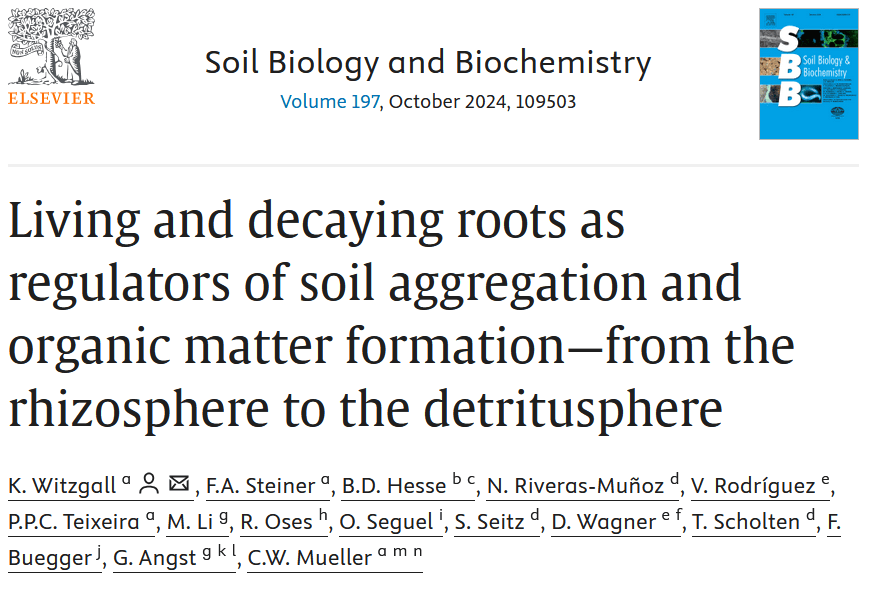
Involved member of MultiTroph: Thomas Scholten
Summary: This study investigated the role of living and decaying roots in regulating soil aggregation and organic matter formation in dryland ecosystems – but will be applied to and was inspired by our BEF-China experiment. Using a two-phase incubation approach, the researchers traced the transition from a living pioneer plant-root system to its decomposition in semi-arid topsoil and subsoil. The results showed that roots are crucial for macroaggregation within the rhizosphere in both soil types and are associated with a strong increase in fungal abundance in the subsoil. In topsoil, the study found that macroaggregation induced by roots persisted even after the plant died, a phenomenon not observed in subsoil.
Conclusion: The research highlights the need for more studies that examine the full temporal dimension from living to dying plants in intact soil systems to gain a holistic understanding of plant-microbe-soil interactions. The findings emphasize the significant role of roots as regulators of soil aggregation and organic matter formation.
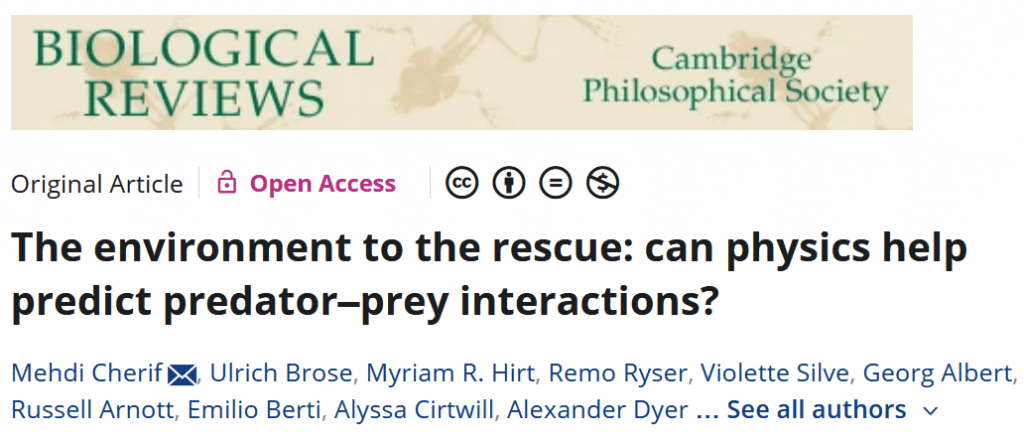
Involved member of MultiTroph: Georg Albert
Summary: This article proposes a mechanistic framework to integrate physical factors, such as temperature, light intensity, and viscosity, into the study of predator–prey interactions by combining the movement ecology paradigm with a modular predation sequence. This approach seeks to explain and predict how interplay between organism traits and abiotic environmental variables regulate trophic interactions and, subsequently, food-web responses to environmental changes, including anthropogenic impacts like climate change and species invasions.
Conclusion: The framework mechanistically links environmental physical factors to the movement components of organisms, enabling quantitative predictions of predator–prey interactions and food-web dynamics in response to changing physical conditions. This integrative approach helps forecast ecosystem responses to anthropogenic stressors by connecting environmental change with ecological interaction strengths and food web structure.

Involved member of MultiTroph: Michael Staab
Summary: Ecological networks of species interactions are popular and provide powerful analytical tools for understanding variation in community structure and ecosystem functioning. However, network analyses and commonly used metrics such as nestedness and connectance have also attracted criticism. One major concern is that observed patterns are misinterpreted as niche properties such as specialization, whereas they may instead merely reflect variation in sampling, abundance, and/or diversity. As a result, studies potentially draw flawed conclusions about ecological function, stability, or coextinction risks. This article highlights potential biases in analyzing and interpreting species-interaction networks and reviews the solutions available to overcome them.
Conclusion: The authors recommend the use of null models in network analysis that account for species abundances. They show why considering variation across species and networks is important for understanding species interactions and their consequences. Network analyses can advance knowledge on the principles of species interactions but only when judiciously applied.
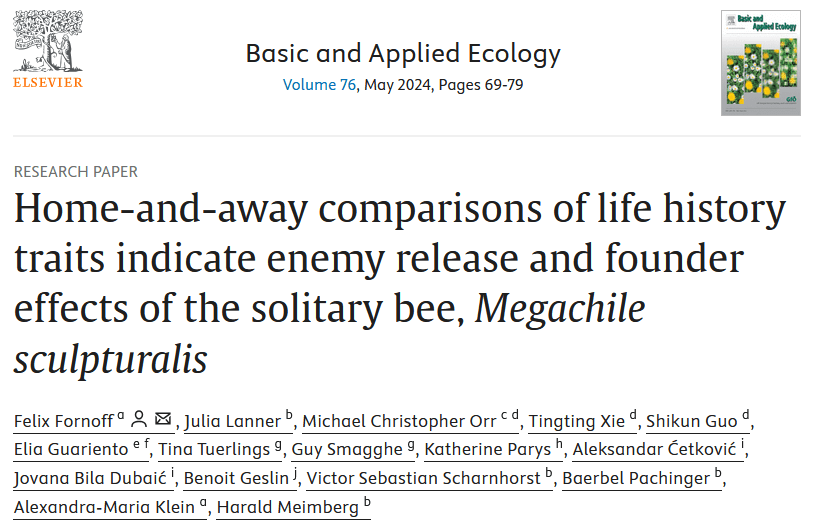
Involved members of MultiTroph: Felix Fornoff, Michael Christopher Orr, Ting-Ting Xie, Alexandra-Maria Klein
Summary: Fornoff et al. conducted a “home-and-away” comparison of the life history traits of the sculptured resin bee, Megachile sculpturalis, which is an invasive species in Europe and North America. The authors compiled data on nest architecture, offspring, natural enemies, body size, and phenology from its native range in Asia and its exotic ranges. The findings indicate that the bees’ phenology shifted to an earlier period in the exotic ranges compared to the native range, and while the overall abundance of natural enemies remained similar, specialist enemies were absent in the exotic regions. The study also found that body size was similar between native and exotic ranges, and that the number of brood cells per nest cavity was significantly higher in Europe than in China.
Conclusion: The comparison of life history traits between the native and exotic ranges of M. sculpturalis suggests that trait shifts may be explained by founder effects or ecological filtering. The absence of specialist enemies in the exotic ranges supports the “enemy release” hypothesis, which may contribute to the species’ reproductive success and rapid spread.
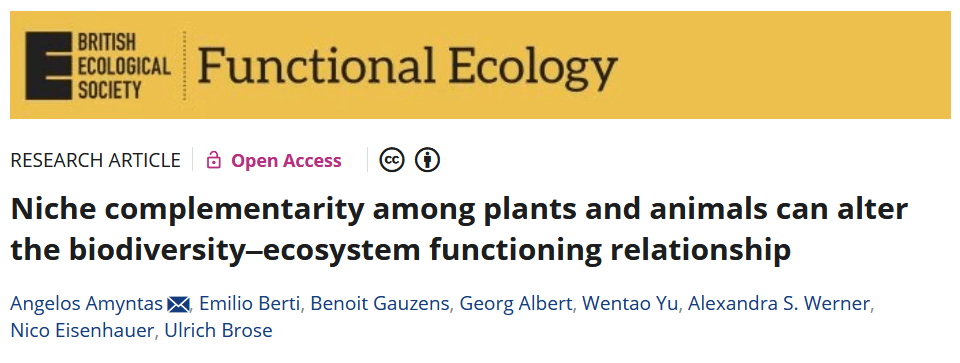
Involved member of MultiTroph: Georg Albert
Summary: This study used a bio-energetic model to investigate how niche complementarity among plants and animals affects the relationship between biodiversity and ecosystem functioning (BEF). The researchers found that increased niche complementarity in plants strengthens the diversity-function relationship, but only if it doesn’t lead to an increase in intraspecific competition. They also found that while increased complementarity among animals can have a positive effect, the outcome is highly variable. The study highlights the importance of the interplay between trait variation within and among species, and the balance between intra- and interspecific competition in shaping ecosystems over time.
Conclusion: The findings suggest that the way in which niche complementarity increases is critical to the biodiversity-ecosystem functioning relationship. The study provides new insights into the mechanisms behind this relationship and has practical implications for ecosystem management and conservation efforts.
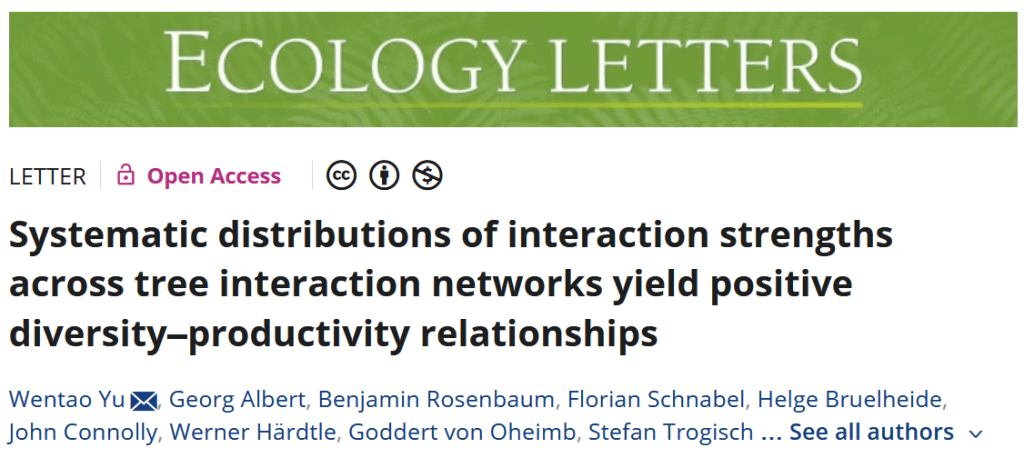
Involved members of MultiTroph: Georg Albert, Helge Bruelheide
Summary: This study investigated the mechanisms behind the positive relationship between tree diversity and productivity (DPRs) by analyzing data from a large-scale forest biodiversity experiment in subtropical China. The research demonstrated that changes in individual tree productivity were driven by species-specific pairwise interactions. It was found that a positive difference between inter- and intra-specific interactions was a critical factor for the emergence of positive DPRs. The study also surprisingly found that the condition for positive DPRs corresponded to the condition for species coexistence.
Conclusion: The results provide a novel insight into how pairwise tree interactions regulate DPRs, and they have implications for identifying optimal tree mixtures to guide forest restoration and reforestation efforts. The findings indicate that the identity of neighboring trees is an essential factor in shaping individual tree productivity.
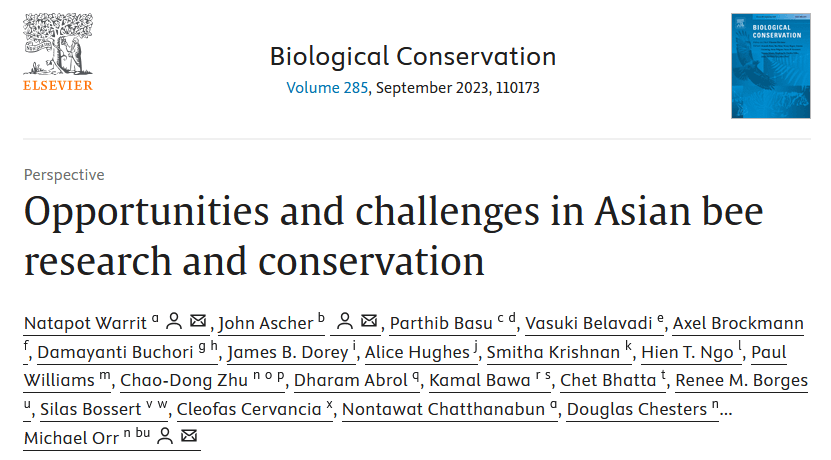
Involved members of MultiTroph: Chao-Dong Zhu, Douglas Chesters, Alexandra-Maria Klein, Arong Luo, Michael Orr
Summary: This paper is a perspective on the challenges and opportunities for bee research and conservation in Asia. The authors, a collaborative group of researchers from 13 Asian countries and beyond, argue that strategies developed in North America or Europe may not be applicable due to Asia’s unique cultures, landscapes, and faunas. They highlight that Asia contains 15% of the world’s bee diversity, but this represents only 1% of the public global bee specimen data, and very few species have been assessed by the IUCN. The paper outlines the special circumstances of Asian bee research, the importance of social bees as flagships for lesser-known solitary bees, and the urgent need for further research for food security.
Conclusion: The authors conclude by outlining a framework for future research in the region, particularly through governmental and other partnerships, to effectively conserve bee species. They emphasize the need to quickly increase regional knowledge and tailor conservation planning to the specific challenges in Asia.
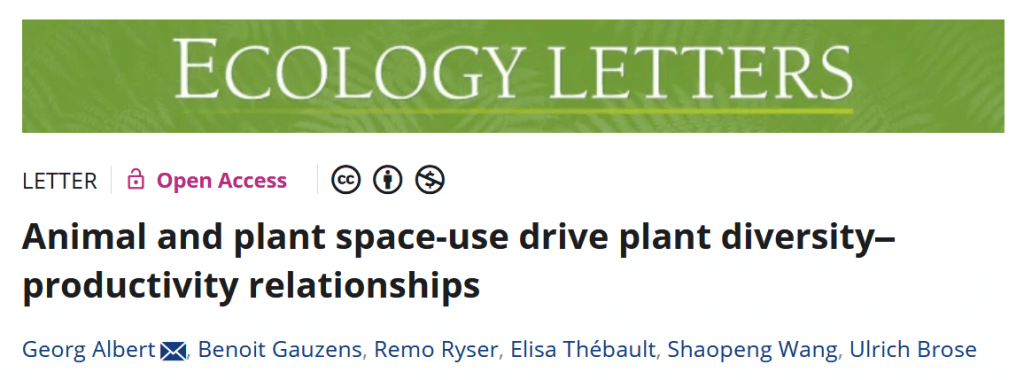
Involved members of MultiTroph: Georg Albert
Summary: Plant community productivity generally increases with plant biodiversity. This positive relationship is rooted in the interactions between plant individuals. Such interactions are often attributed to resource competition but can be similarly mediated by animals. However, while resource-based plant interactions are spatially local, the spatial scale of animal-based interactions varies depending on the animals involved. To understand the consequences of this scaling differences for plant diversity-productivity relationships, we simulated plant communities under different space-use scenarios and along a diversity gradient. We show that plant and animal space-use can drastically alter competition within plant communities. Specifically, strong animal-based competition from herbivore space-use can lead to negative diversity-productivity relationships. However, space-use of larger top predators integrates sub-food webs composed of smaller species, offsetting potential negative effects of herbivore- and resource-based competition on plant communities.
Conclusion: Differences in animal space-use modify competitive interactions throughout food webs and introduce substantial variation in how plant communities respond to changes in plant biodiversity. Understanding how the spatial realization of feeding interactions differs between animal communities will help identifying drivers of biodiversity effects and can serve as a framework for linking local and landscape processes.
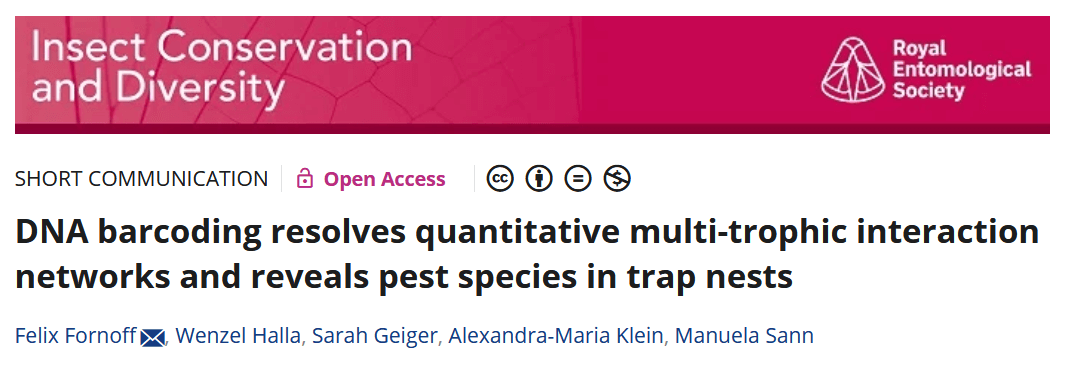
Involved members of MultiTroph: Felix Fornoff, Alexandra-Maria Klein, Manuela Sann
Summary: This study used DNA barcoding to reconstruct quantitative three- and four-trophic interaction networks of cavity-nesting wasps, their prey, and natural enemies. The research identified previously unknown predator-prey interactions, including prey species that are known as agricultural and forest pests. The authors found that trap nests, when combined with DNA barcoding, are a valuable tool for monitoring these multi-trophic interactions and for revealing unknown feeding links.
Conclusion: This study used DNA barcoding to reconstruct quantitative three- and four-trophic interaction networks of cavity-nesting wasps, their prey, and natural enemies. The research identified previously unknown predator-prey interactions, including prey species that are known as agricultural and forest pests. The authors found that trap nests, when combined with DNA barcoding, are a valuable tool for monitoring these multi-trophic interactions and for revealing unknown feeding links.

Involved members of MultiTroph: Michael Staab, Yi Li, Naili Zhang, Keping Ma, Xiaojuan Liu
Summary: Extrafloral nectaries (EFNs) are nectar glands outside plant flowers. By providing a sip of notorious and sweet liquid, plants with EFNs attract ants and other natural enemies that may reduce herbivore loads. Such ‘food-for-protection’ mutualisms have been studied extensively for plants with EFNs. However, it was unknown whether this mutualistic association also benefits neighboring plants that do not produce extrafloral nectar. We now show that trees neighboring EFN trees have more ants and fewer herbivores compared to conspecific control trees without EFN-bearing neighbors. Concurrently with the changes in the arthropod community, the composition of leaf traits potentially related to plant defense shifted. These novel results suggest that when trees without EFNs benefit from lower herbivore loads as a result of predatory ants spilling over from EFN-bearing neighbors, resource allocation into defense could be lowered, which would free resources for growth.
Conclusion: Facilitation between plant species, an important mechanism behind biodiversity-ecosystem functioning relations, can be driven by mutualistic predators that enhance conditions for plants without defense mutualisms. As plants with EFNs are common in tropical and subtropical floras, the revealed mechanisms may be widespread and functionally important. For example, adding EFN species to species pools in reforestation and restoration projects could foster herbivore control, growth and other ecosystem functions.

Involved members of MultiTroph: Felix Fornoff, Michael Staab, Chao-Dong Zhu, Alexandra-Maria Klein
Summary: Plant diversity affects multi-trophic communities, but in young regrowth forests, where forest insects are in the process of re-establishment, other factors might be more important. We showed in the BEF-China experiment that tree diversity was not important, but tree biomass and canopy cover, mediated by changes in microclimatic conditions, were important for the bee, wasp and natural enemy community re-establishment.
Conclusion: Although maximizing tree diversity is an important goal of forest reforestation and conservation, rapid closure of canopies is an important driver for re-establishing communities of forest bees, wasps and their natural enemies.